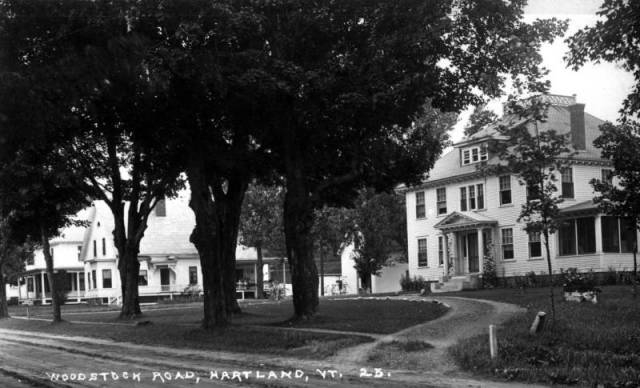Lewis E. Merritt 1868-1946
Now to honor Leon Royce’s request that Lewis Merritt be featured in the H.H.S. newsletter. When Leon was growing up in the house next to Damon Hall on the main street, the Merritts lived just up the street in the fine house now occupied by Larry and Jeannie Frazer. Of course, now I wish I had quizzed Leon more about his recollections of Lewis Merritt.
An earlier Lewis Merritt, Stephen Hammond, and Harvey Lamb came to Hartland from Charlton, Massachusetts. In 1817 they leased a grist mill in the gorge below what is now the Rte. 5 bridge from Aaron Willard. Having access to a supply of grain, the partners soon established Hartland’s first commercial distillery. Hartland was booming at that time. Several dams and mills had existed for decades on Lulls Brook from the village to the Connecticut River. By 1852, L. H. Merritt had consolidated all the mill privileges in the gorge, and the area became known as Merritt Mills for the next 60 years. In 1878 Asa Merritt, Lewis E. Merritt’s brother, purchased the mills, which included a saw mill, grist mill, and cider mill. The Hartland Historical Society’s 100th Anniversary 2016 calendar features a 1900 picture of the log yard and Asa’s house, which still stands south of the bridge. The calendar’s May picture shows some of the mill buildings. In 1911 a fire caused by an overheated bearing destroyed the entire complex.
Lewis E. Merritt continued the family business of building and operating mills. By 1911 he had built a saw mill, grist mill, and cider mill on a rise above the Rte. 5 bridge. The mills were powered by electricity generated at Asa’s mill site down in the gorge. The tall red grist mill still stands as a landmark visible when entering or leaving the village. The foundations of the saw mill and cider mill are still visible. In 1950 Herb Ogden removed their works to his place on Jenneville Road.
Besides the house where, it was said, the gardens were the showpiece of the Village, there was a Merritt farm. It was just up the hill from the Quechee Road on what is now Mt. Hunger Road. Mr. Merritt sold cattle as well as lumber. He may also have been a breeder of fine horses, as H.H.S. has accounts of his selling stock out of state. He also owned a lot of land. The first Lewis Merritt in Hartland went into business when Hartland was one of the larger towns in the county, with a population of 2500. A hundred years later, the population was only half that; Lewis E. Merritt was probably the most prominent and wealthiest man in what was then a town in decline economically. It must have been a buyer’s market for land. For people with hill farms who needed or wanted to sell so they could leave for greener pastures, Mr. Merritt may have been one of the few who had both the means and the inclination to buy land. My grandparents, Guy and Ada Best, worked on the Merritts’ home farm, and that may have been where they met. After marrying, they farmed at Ogden’s, a farm I’m pretty sure Lewis E. Merritt owned. In 1915, ten years after they married, they were able to buy a farm from Mr. Merritt. I sense Mr. Merritt was somewhat of a facilitator during what were tough times for many townspeople. He could buy farms from those who wanted to sell and he could put on those farms people who didn’t have the means to buy. Mr. Merritt was definitely an administrator as his name shows up in many transactions, such as settling estates. It’s apparent that he was regarded as a man of integrity who people turned to for help.
That said, H.H.S. has a newspaper clipping indicating at least one person found fault with Mr. Merritt’s character. In 1926 his sister-in-law, Anna Merritt, sued him for $50,000! Her husband Henry had died in Florida in 1923, and Anna claimed emotional distress because Lewis E. Merritt was “circulating talk” in
Hartland that she had poisoned her husband. It must have been a spurious claim or quietly settled because nothing else about it appeared in the paper.
As Leon Royce told me, Lewis Merritt did a lot for the town. Along with his business dealings and farming, Mr. Merritt found time to serve as a Selectman and President of the Cemetery Association.
So next time you’re passing through town, notice Lewis’s fine house on the main street. Note what was for decades Hartland’s lone sidewalk that runs in front of it—Mr. Merritt built that in 1928. At the center of the village you’ll see the soldier’s monument that Mr. Merritt gave the town in 1930. Leaving town, you’ll see the tall red grist mill where Mr. Merritt’s businesses were located. After crossing the bridge, Asa’s house is on the right—the Merritt fortunes were started in the long deep gorge across the road.
 The Merritt House on Rt. 12 (on the right)
The Merritt House on Rt. 12 (on the right)
Les Motschman, with help from H.H.S.Board Member Pip Parker, who researched the Merritts, and H.H.S. member Jay Boeri, who operates a hydro station in the gorge and knows a great deal about the many previous owners and their mills.